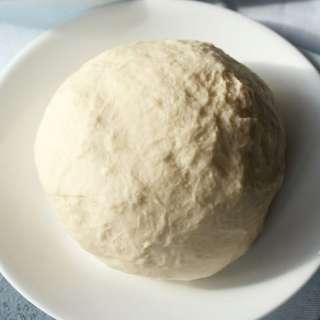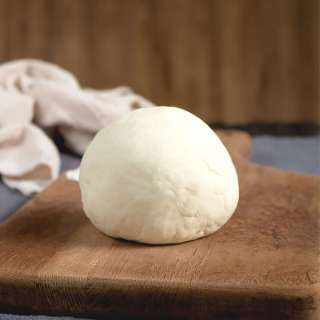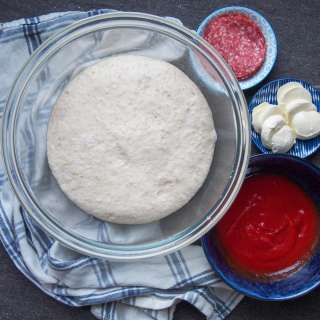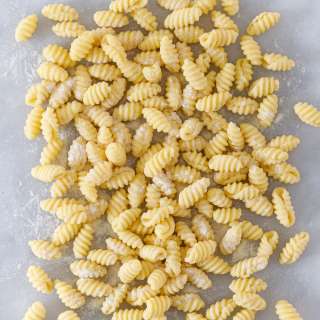
Sourdough Pizza Dough (No Yeast)
User Reviews
5.0
3 reviews
Excellent
-
Prep Time
20 mins
-
Rising Time
3 d 12 hrs
-
Total Time
3 d 12 hrs 20 mins
-
Servings
12 small pizzas
-
Calories
294 kcal
-
Course
Main Course
-
Cuisine
Italian

Sourdough Pizza Dough (No Yeast)
Report
The natural fermentation process of sourdough imparts a rich, tangy flavor and a delightfully chewy texture, perfect for a no yeast sourdough pizza dough.
Share:
Ingredients
Levain:
- 150 g active sourdough starter
- 185 g lukewarm water (80-90 degrees F)
- 115 g bread flour
Pizza Dough:
- 450 g lukewarm water (80-90 degrees F)
- 20 g salt
- 750 g bread flour
- 30 g olive oil
Instructions
Levain:
- Add starter to a large bowl. Pour warm water over the starter.
- Add bread flour and salt to the bowl.
- Mix the ingredients together with a dough whisk.
- Cover the bowl and let it rest for 10-12 hours at room temperature. I like to use a clean shower cap, but you can use a damp tea towel or plastic wrap.
Pizza Dough:
- The next morning, after the levain has risen for 10-12 hours, add water to the bowl with the levain. Stir with a dough whisk to combine.
- Add salt and bread flour to the bowl. Stir with a dough whisk until a shaggy dough forms. Cover the bowl and let the dough rest for 30 minutes.
- After the dough has rested for 30 minutes, drizzle olive oil over the dough. Knead by hand to incorporate the olive oil into the dough. Cover the bowl and let it rest for 1 hour.
- After the dough has rested for 1 hour, use a silicone bowl scraper to pull the dough away from the bowl edges.
- Gently pull one end of the dough above the bowl until it can't stretch anymore without coming out of the bowl. Then fold the dough in half over itself. Rotate the bowl 90 degrees and repeat the process. Repeat until the dough starts to feel tight and resists stretching, about 6-8 times. Cover the bowl and let it rest for 1 hour.
- Repeat the stretching, folding, and resting process 2 more times (3 times total). Cover the dough and let it at room temperature for 6-8 hours or until the dough is 2-3 times its original size.
- Generously grease a proofing box or 9x13 glass baking dish with olive. Grease the lid or dish cover too!
- On a lightly floured work surface, divide the dough into 12 or 6 equal pieces, depending on the desired size of the pizzas.
- Shape each dough piece into a tight ball. Start by stretching each piece of dough into a rough circle. Fold the dough into the middle and pinch the edges together. Use a bench scraper to pull the sides of the dough ball under itself, making the surface tight.
- Place the dough balls into the greased box or dish. Add a drizzle of olive oil over the top of the dough balls. Gently spread the olive oil over each dough ball.
- Cover the proofing box and refrigerate for 18-42 hours. The dough can be baked with after 1 day of resting on the fridge, but the flavor is better after another day.
- Approximately 4-5 hours before you plan to make pizzas, remove the dough from the fridge. Let the dough sit at room temperature for the final rise.
- Preheat your pizza oven, oven, or grill to its highest setting.
- Working with 1 dough ball at a time, place the dough ball on a generously floured pizza peel or pizza pan.
- Gently press your fingers into the dough, starting at the top and working your way to the bottom, until the dough is covered in indentations. Don't let your fingers go all the way through the dough to the work surface.
- Cup your hand into a C shape and gently press around the circumference of the dough, near the edge around the whole dough circle.
- Gently pick up the dough circle and stretch the dough between your hands until a larger circle is formed. Rotate the dough circle several times between stretches to make sure the dough has an even thickness, about ¼" thick in the middle and a little less than ½" thick on the edges.
- Once the dough has reached the desired size, shape, and thickness, place it back on the floured surface. Add sauce, cheese, and toppings as desired.
- Baking times will vary on your cooking method. A small pizza will take about 10-12 minutes in a 500℉ oven or 4-5 minutes in a 900℉ pizza oven.
- Slice and enjoy!
Equipments used:
Notes
- Sample Schedule:
- Day 1:
- Day 2:
- Day 3:
- Day 4:
- Sourdough starter can either be made at home or purchased in various forms (typically dried). I used this guide for making a sourdough starter and it hasn't failed me yet. It's important to note that sourdough starters are all different in yeast cultures, consistency, yeast activity, etc. and it may take time to figure out how your starter works with specific recipes.
- Not all bread flours are created equal. The protein content and type of wheat used can drastically affect the outcome of your dough. I get the best results with King Arthur bread flour which has a higher protein content than most bread flours. That's not to say you can't use any type of bread flour, but you may have to test the recipe a few times and adjust it to your liking.
- I use Redmond Real Salt for baking, which is unrefined and has a lower sodium content per gram than regular table salt. If you are using refined table salt, cut the salt down to 15-18 g to make up for the higher sodium content.
- Olive oil is the key ingredient that makes this a pizza dough recipe and not a sourdough bread recipe. Olive oil softens the dough and makes it easier to shape. It also adds wonderful flavor to the dough.
- A dough whisk is great for mixing dough but it isn't necessary. You can mix this dough with your hands or another clean kitchen utensil as well.
- A proofing box is a handy tool for allowing dough to rest and rise at optimal humidity. If you don't have a proofing box, you can also use a glass baking dish covered with plastic wrap.
- 10 am: Feed the starter.
- 6:30 pm: Make the levain.
- 6:30 am: Add the dough ingredients (except olive oil) to the levain. Combine until a shaggy dough forms.
- 7:00 am: Incorporate the olive oil into the dough.
- 8:00 am: Stretch and fold the dough and cover the bowl.
- 9:00 am: Stretch and fold the dough and cover the bowl.
- 10:00 am: Stretch and fold the dough. Cover the bowl and let the dough rise at room temperature.
- 6:30 pm: Shape the dough into small or large balls depending on the desired pizza size.
- 7:00 pm: Place dough balls into an olive oil-greased proofing box or glass baking dish. Cover and refrigerate.
- Leave the dough in the fridge on day 3 to develop more flavor. You can bake with it on day 3, but the flavor is better on day 4.
- 1:00 pm: Remove the proofing box or glass baking dish from the fridge. Let the dough sit at room temperature for the final rise.
- 5:30 pm: Prepare pizzas.
Nutrition Information
Show Details
Calories
294kcal
(15%)
Carbohydrates
55g
(18%)
Protein
9g
(18%)
Fat
4g
(6%)
Saturated Fat
1g
(5%)
Polyunsaturated Fat
1g
Monounsaturated Fat
2g
Sodium
650mg
(27%)
Potassium
72mg
(2%)
Fiber
2g
(8%)
Sugar
0.2g
(0%)
Vitamin A
1IU
(0%)
Calcium
13mg
(1%)
Iron
1mg
(6%)
Nutrition Facts
Serving: 12small pizzas
Amount Per Serving
Calories 294 kcal
% Daily Value*
| Calories | 294kcal | 15% |
| Carbohydrates | 55g | 18% |
| Protein | 9g | 18% |
| Fat | 4g | 6% |
| Saturated Fat | 1g | 5% |
| Polyunsaturated Fat | 1g | 6% |
| Monounsaturated Fat | 2g | 10% |
| Sodium | 650mg | 27% |
| Potassium | 72mg | 2% |
| Fiber | 2g | 8% |
| Sugar | 0.2g | 0% |
| Vitamin A | 1IU | 0% |
| Calcium | 13mg | 1% |
| Iron | 1mg | 6% |
* Percent Daily Values are based on a 2,000 calorie diet.
Genuine Reviews
User Reviews
Overall Rating
5.0
3 reviews
Excellent
Other Recipes















